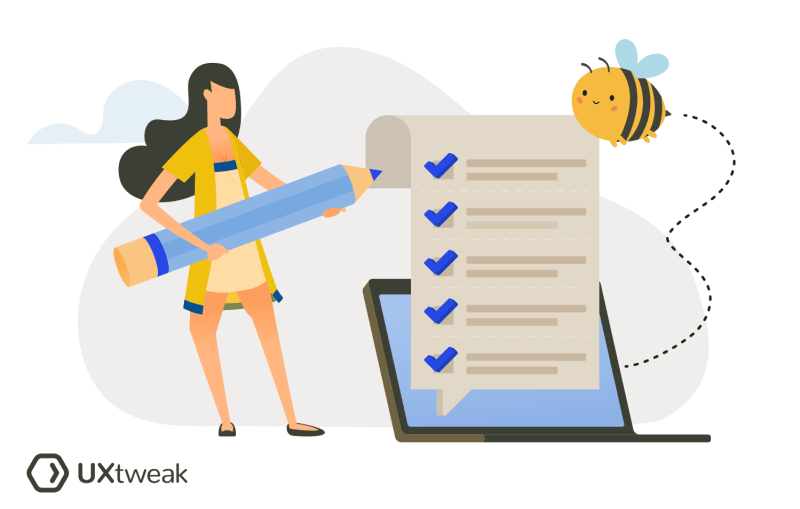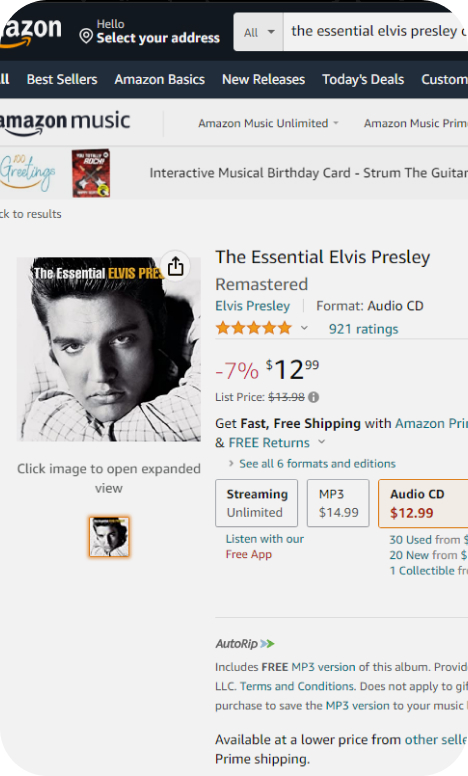Validating the market before fully launching a product minimizes the risk of investing time, money, and resources into something that may not be successful. Here, we have covered everything you need to do to conduct market validation successfully.
Every amazing product idea becomes profitable when there’s equal demand in the market. If not, all the time and money spent developing the idea goes to waste, as your ideal users expect more.
That’s where understanding the needs, pain points, and expectations of your potential customers becomes crucial. Whether you are thinking of launching a new product or changing your existing offerings, market validation can help.
But how to conduct market validation? What are the tools that can help? What are the things we must do and the ones we must avoid? Today, we will cover everything you need to know to ensure you are on the same page as your targeted users.
What is market validation?
Market validation is the process of determining whether there is a need or demand for a product or service within a target market. It helps ensure your product is needed by potential customers and will be well received in the market.
Designing a product that you feel is needed without studying the demand for the product in the market can lead you to losses. Therefore, it’s crucial to collect data on the needs, preferences, and purchasing behavior of customers before investing any significant resources.
Market validation VS market research
Market research is about understanding and identifying existing markets to ensure there is a demand for your product. As Marc Andreessen aptly puts it, “The market you’re going after has to exist independent of your product. You can’t create a market from scratch.” This means that your product should target an already established market with active demand.
On the other hand, market validation is the process of ensuring that your product or service meets the needs and preferences of your target customers before fully launching it.
Philip Kotler captures this idea succinctly:
Importance of market validation in UX
Here are some key ways in which market validation can help to enhance user experience:
Verifying product concepts
There are aspects of your products that users will find appealing and the ones that need improvement. Testing your ideas with real users early on helps ensure you identify these areas and act accordingly.
It prevents you from investing time and resources into developing features that users do not need and helps to save costs in the long run. Therefore, market validation helps to cross-check product concepts with user feedback to create a product that is aligned with user expectations.
Meeting user demand
Market validation helps answer a crucial question: What do users truly want and need from your product?
Clarity on that helps create products that accurately meet those demands. As your product caters to users demand, they are more likely to invest money in it.
Prioritizing between features
Not all features are equally important to users. Market validation helps you prioritize features based on user feedback and preferences. Knowing which features users value the most, you can focus your development efforts on what matters most to them.
For instance, a fitness app developer has several feature ideas, such as workout tracking, meal planning, and social sharing. However, beta testing and user surveys revealed that users are most excited about the workout tracking feature.
The developer then prioritizes this feature and works on perfecting it for users. This way, you are prioritizing and delivering the features that users expect the most from your product.
Reduced development risks
Launching a flawed product can cost a company a lot of money in post-launch fixes. Market validation helps identify these costly flaws early on and make all significant adjustments. Making these adjustments in the initial stages helps save you from spending a lot more time and resources in making changes.
Improved user retention
When you tick all the boxes of user needs, you are likely to retain them for a long period. Market validations help ensure this by incorporating user feedback and preferences into the product. As the final product aligns with users’ needs, they will continue using it for the longest time.
Top 7 market validation methods
Now that we know why validating your ideas is important, here are some top methods of conducting market validation.
User interviews
Having a one-on-one conversation with your potential customers is one of the best ways to validate your product idea. User interviews can give you detailed insights into their needs, preferences, and pain points.
For instance, a startup is developing a new project management tool. Conducting one-on-one interviews with project managers can help validate their ideas. As a project management tool has different features, asking specific questions related to each feature can help to prioritize specific features’ development.
For the time tracking feature, for example, you can ask: Do you currently track the time spent on different tasks and projects? If so, how?
If most users struggle with tracking the time spent on different tasks, you know which area to focus on. The point is to focus on asking the right user interview questions and actively listen to their answers.
Usability testing
Watching how users interact with your product, the challenges they face during interaction, and how they navigate through the product can provide the insights you need to make necessary improvements.
As users interact with your product, you can identify usability issues and navigation patterns that confuse them. Dealing with these issues early on makes your product user-friendly and improves market acceptance.
However, asking the right questions and giving the right tasks is crucial to making the most of usability testing. Focus your questions on specific aspects of the product experience to gain insights you can implement. To make asking questions easier, we have curated a visual guide to usability testing questions that will help!
Another way to use usability testing as a market validation method is by testing your competitor’s products. This way you can pinpoint areas in which your competitors’ products are lacking and make them a market advantage for your own product.
See how usability testing works in these demos:
Surveys
Marketers frequently use surveys to assess product-market fit using data from a large sample of potential customers. In fact, a Statista report revealed that 85% of marketing professionals claimed they use online surveys regularly, making it one of the top-ranking quantitative methods. This is followed by mobile surveys (47%) and proprietary panels (32%).
Get clarity on what you want to validate or learn from the market such as identifying interest in a product idea, customer pain points, or gauging preferences of certain features. Once you know what you want to validate, you can craft your survey questions accordingly.
Use a blend of qualitative and quantitative questions to validate different areas of the product. Based on users’ responses, make the necessary changes.
A/B testing
A/B testing can help when you have different versions of a product or feature. It can help assess which version resonates better with your target audience. You can use it to test different UI designs, feature placements, pricing methods, or checkout processes to reveal which options users find more intuitive.
Let’s say you want to validate the pricing model for a subscription app. You have two models in mind- the first one focuses on affordability, and the second on delivering premium features and exclusive content.
Pricing model A:
- Subscription price: $9.99 per month
- Offer: First-month free trial, followed by automatic renewal
- Benefit highlight: Focus on affordability with no long-term commitment.
Pricing model B:
- Subscription price: $19.99 per month
- Offer: No free trial but includes access to premium features and exclusive content
- Benefit highlight: Focus on providing premium features and exclusive content.
Testing these two models with a focus on conversion rates, engagement, and revenue per user will help validate which pricing model performs better. You might realize that the audience is more inclined towards affordability and choose it over premium features.
Once you know that users prioritize affordability, you can launch the variation that focuses more on it and garner better engagement.
Competitive analysis
Observing your competitors’ strengths and weaknesses is crucial to finding market gaps and shaping your proposition. While conducting a competitive analysis, consider both direct competitors—those offering similar products—and indirect competitors—those providing alternative solutions that meet the same customer needs.
Go through market research reports, competitors’ social media and website pages, or gather insights directly from customers through surveys and interviews. The goal is to understand what your competitors excel at and where they fall short so that you can enhance your own offerings accordingly.
Focus groups
A small yet diverse group of potential customers can share opinions and experiences regarding your product or service. It allows you to gain deep insights into the areas they struggle with to modify your offering accordingly. Open discussions with these people can help shape your product development and marketing strategies.
While selecting your focus groups, have clear objectives and select participants who represent your target market. Prepare a list of questions to guide the discussion, focusing on key areas like product features, usability, and overall customer satisfaction.
Fake door testing
Fake door testing is a market validation technique where you present a product or feature to customers as if it exists, even though it’s not yet available. It helps gauge customer interest and demand before investing time and resources into development. You can use this method to validate assumptions about new features, product ideas, or changes to existing offerings.
For instance, say you’re considering adding a new feature to your app that allows users to create custom reports. You create a new button on your app’s interface labeled “create custom report” and track how many users click on it. When users click the button, they are taken to a page that explains the feature is coming soon and invites them to sign up for updates.
How to conduct market validation?

Let’s now look at the steps to conduct market validation.
1. Define the proposition
Your proposition defines what your product or service is, the problem it solves for customers, and the target market segment it services. It helps clarify your product’s value and how it aligns with customer needs and market opportunities.
Let’s understand how to define the proposition with an example. Say you are designing a task management app called X for startups with limited resources. Start with defining your product:
“X is a mobile and web-based application task management platform designed for startups to streamline project organization, track milestones, and enhance team collaboration.”
Next, focus on the problem your product helps solve:
“Taskify helps with the challenge startups face in managing multiple projects efficiently with limited resources.”
Now, define the target market segment you cater to:
“Taskify targets early-stage startups and small businesses that need an affordable yet efficient task management solution.”
Once you know the target market segment, next comes the assumptions you have for them. For instance, “Startups prioritize cost-effective solutions that scale with their growth.” You will have many such assumptions regarding your target segment, the problems they deal with, and the solutions they prefer, which may or may not be true.
Use assumption mapping to map out all your assumptions about the product and the market segment. Validate these assumptions using methods such as interviews and target customers accordingly.
Learn how to conduct assumption mapping in this quick video👇
2. Conduct market research
Now, let’s focus on the total number of potential customers or businesses that could benefit from your product or service. At the same time, when a new product enters the market, there are barriers that prevent it from succeeding in the existing landscape.
These barriers could be:
- Government regulations or licensing requirements
- High capital requirement to enter a new market
- Limited access to distribution networks
- Competitor’s technological advantages
- Convincing customers to switch from their existing brand
Jot down all possible barriers that can hinder your entry into the new market. While doing so, keep an eye on the competition to understand their pricing structure, marketing messages, and potential gaps that can benefit you.
To make things simpler, use market research tools to extract relevant data and make decisions accordingly.
3. Create your UX persona
UX personas are detailed representations of your ideal users. If you are unaware of who those people are, you are less likely to validate a product idea. Create your user persona by focusing on the demographics, behaviors, and pain points of your ideal customers.
During market validation, these personas act as a reference point to validate assumptions about user behaviors and preferences. When you test your product proposition against these personas, you can gather feedback early in the development process.
Moreover, knowing your users inside out can help you design user experiences that are more tailored to their needs, increasing satisfaction and retention.
4. Choose validation methods and recruit users
You can choose from any of the top validation methods we discussed earlier, such as user interviews, usability testing, A/B testing, surveys, focus groups, and more. You can also blend these methods and begin the process accordingly.
Once you decide on the methods, the next step is to recruit users. Use online platforms, social media, email lists, or user panels to recruit respondents that align with your requirements.
5. Validate the product concept
Now, we have a pool of respondents who can help provide insights related to the product concept. They can help you understand whether or not your concept aligns with their needs and addresses their pain points.
User interviews work best here as you can directly talk to potential customers and gather their insights. In fact, according to Statista, online in-depth interviews with webcams (34%) and online focus groups with webcams (28%) are the most commonly used qualitative methods among researchers.
However, the quality of your questions will determine whether you can use the feedback generated to improve your concept. Many times, cognitive biases can hinder our thinking process, and we ask questions based on preconceived notions.
But to get responses that can actually help improve the concept, you need to conduct user interviews with questions that focus on extracting real insights. Learn how to write good user interview questions.
6. Create a MVP
Develop a simplified version of your product that includes only the essential features needed to solve your target audience’s core problem. This will help you quickly build and launch a basic product without investing too much time and resources.
For example, if you are creating a mobile app for meal planning, your Minimum Viable Product (MVP) should include basic features like:
- A simple user interface for selecting meals
- A calendar to schedule meals
- A grocery list generator based on selected meals
The MVP will address the core need (meal planning) without including advanced features like personalized nutrition tracking or social sharing options.
7. Test the MVP with users
Once you have a basic version of your product, present it to your audience and gather feedback. Use a blend of validation methods to gather diverse perspectives.
Taking the meal-planning app example forward, after users test your app, conduct user interviews to understand their experience, likes, and dislikes. They can suggest the advanced features and functionalities they expect from the app.
While they navigate through the app, conduct usability tests to identify any usability issues or areas of confusion. A/B testing can help here if you want to test which features are preferred among your ideal users. You can also send out surveys to collect quantitative data on user satisfaction, ease of use, and feature preferences.
The idea is to extract feedback using different methods to ensure a clearer picture of users’ needs and expectations.
8. Regularly collect feedback and improve UX
Keep collecting feedback during different stages to enhance your product and ensure your offering aligns with their expectations. The product will also evolve based on user needs and preferences, increasing satisfaction and retention.
5 best practices to follow during market validation

During market validation, here are some practices that will help:
Know what you want to achieve
Market validation can be done to assess the demand for a product, identify customer pain points, or evaluate the competition. Knowing what you want to achieve ensures you structure your validation process accordingly.
Define your target segments
When validating a product concept, you must ensure you are targeting the right users. Thoroughly define your ideal users based on demographics, behaviors, and pain points. It ensures you are validating your product with the right audience who are likely to purchase your offering.
Use a blend of validation methods
Don’t get stuck on one validation method; use a blend of methods to gather insights. Qualitative methods such as one-on-one interviews and focus groups help deepen understanding of user needs, while quantitative methods such as surveys give insights into broader trends.
Validate your assumptions
It’s easy to assume what your target users may or may not prefer. Validating these assumptions about user needs, pain points, willingness to pay, and other crucial factors helps improve the chances of market success.
Keep an eye on the competition
When introducing a new product, it’s crucial to fully understand the current competitive landscape. Know your competition and growth potential thoroughly to position your product better and sell your USPs.
5 mistakes to avoid during market validation

Here are the things you must avoid when conducting marketing validation:
Falling into the trap of confirmation bias
It’s normal to make decisions based on preconceived notions during market validation. That’s where it’s crucial to objectively test assumptions instead of looking for cues to validate what we know all along. Once you receive user feedback that differs from your assumptions, make it a point to act on it.
Ignoring diverse feedback
Making decisions based on feedback from a limited sample is easy. However, it can prevent you from understanding the broad needs of a target market. You might get a positive response from a few users who think alike. However, you need to target a group of diverse potential customers to capture a broad perspective.
Overlooking competitive analysis
You can’t position your product in the market if you ignore competitive threats. Simply focusing on making your product offerings better is not enough. Understanding their selling points and market gaps can help you improve your strategy.
Not validating the willingness to pay
You cannot go solely by the interest or need for the product and avoid the willingness to pay. In the end, even if there is a huge need for a certain product, if it is priced heavily according to the target users, it’s less likely to sell. Have pricing discussions early on to avoid this confusion.
Rushing the validation process
Rushing through the validation process and jumping to conclusions compromises insights. Conduct your research thoroughly, avoid skipping validation steps, and experiment with a blend of methods to reach the right conclusions.
- UXtweak
- Loop 11
- Userlytics
- SurveyMonkey
- UserTesting
1. UXtweak
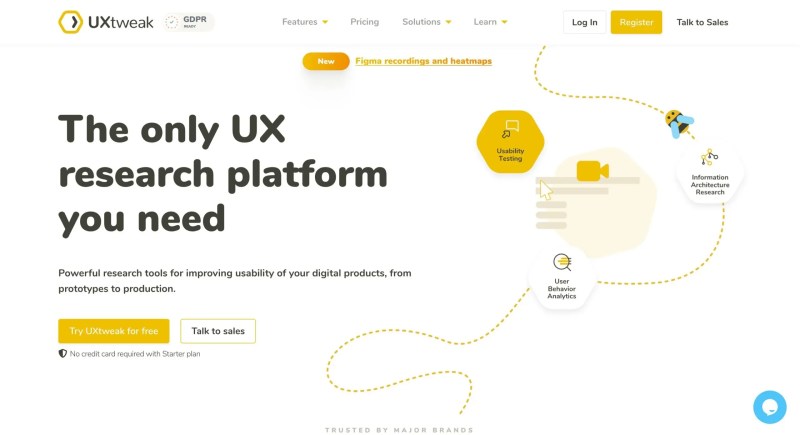
UXtweak is an all-in-one UX research platform that offers various tools to help validate your product ideas. These tools include online surveys, prototype testing, session recording, website testing, mobile testing, and more. With UXtweak, you can gather valuable user feedback, understand user behavior, identify usability issues, and refine your product to better meet market needs.
The best part about choosing UXtweak is that it lets you experiment with a blend of market validation ideas, which is crucial to generating diverse perspectives. It also provides you with a pool of respondents you can use to conduct surveys and usability testing. Such a comprehensive approach ensures that your product is validated effectively before a full-scale launch.
Features
Pros
- All the tools you need in one place
- Advanced analytics provide detailed insights into user behavior and preferences, helping to identify and address usability issues
- Allows for the collection of real-time user feedback, enabling quicker iterations and improvements
- Easy to navigate, making it accessible for teams with varying levels of technical expertise
- Suitable for both small projects and large-scale research, adaptable to your needs
- Multiple recruiting options
- Free plan
Cons
- Dashboard can be confusing at first, but it gets easier with practice
User reviews
According to Capterra:
Overall score – 4.3/5
Ease of Use – 4.6/5
Customer Service – 4.6/5
Pricing & Plans
- Plus package: starts at $59
- Business package: starts at $151
- Enterprise package: custom pricing
Try it yourself and see how easy it is to conduct research with us 🐝
2. Loop 11
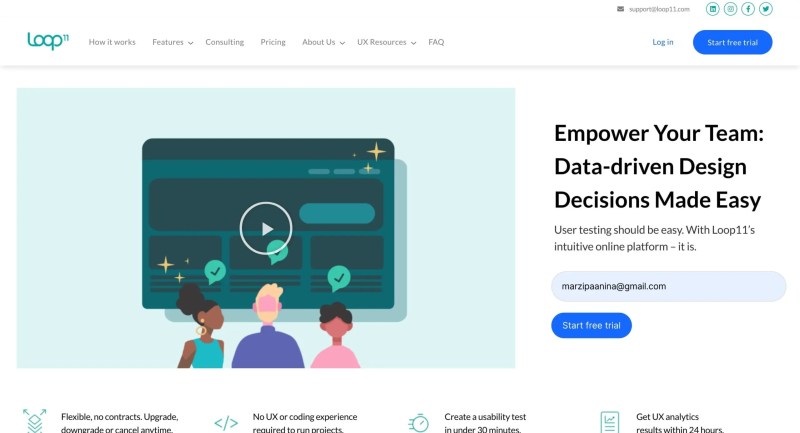
Loop 11 helps you create and run user experience tests to collect insights on how real users interact with your website, app, or prototype. Observing user behavior and gathering their feedback can identify usability issues and validate whether your product meets the market’s needs.
Features
- Online usability testing
- UX benchmarking
- Prototype testing
- A/B testing
Pros
- Smooth data collection
- Easy-to-use interface
- Provides both audio and visual feedback
Cons
- Limited customization options for usability testing and surveys
- Has a learning curve
- The pricing structure might not be suitable for small businesses
User reviews
Capterra: 4.5/5
Pricing & Plans
- Rapid insights: $179/month
- Pro: $399/month
- Enterprise: $599/month
3. Userlytics
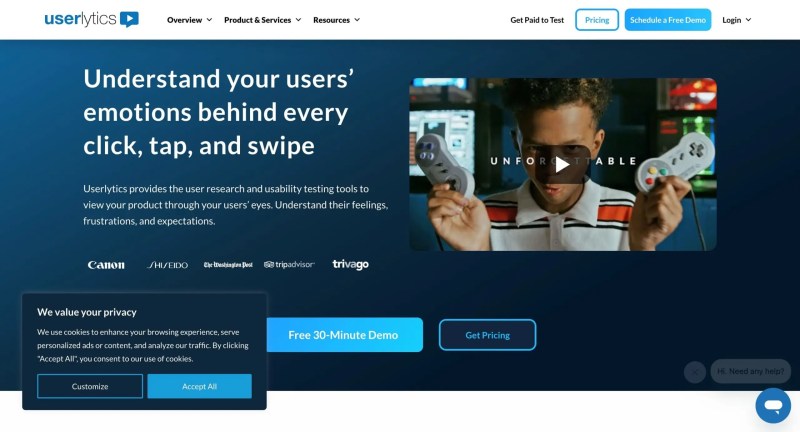
Userlytics helps in market validation by providing direct insights through remote usability tests. It also helps you gather feedback through video recordings and screen captures to understand usability challenges better.
Features
- Task-based testing
- Heatmaps and click analysis
- Iterative testing
- Demographic filtering
Pros
- Remote testing removes the location barrier
- Offers comprehensive data in different formats
- Iterative testing cycles ensure continuous refinement of ideas
Cons
- It can be expensive for frequent or extensive testing sessions
- Setting up and managing tests may require technical assistance
- The quality of testers isn’t always up to the mark
User reviews
Capterra: 4.6/5
Pricing & Plans
Custom plans.
4. SurveyMonkey

SurveyMonkey is a helpful tool for market validation as it helps businesses create surveys that gather feedback directly from potential customers. It also provides analytics tools that turn survey data into actionable insights. Businesses can visualize trends and make decisions about product development.
Features
- Customizable surveys
- Targeted audience selection
- Quantitative data collection
- Analytics and reporting tools
Pros
- Customization features help tailor surveys to the needs
- Data analytics help extract valuable insights
- Offers various pricing plans for different budgets
Cons
- Risk of respondents feeling overwhelmed by surveys
- Provides no options for editing surveys
- The platform crashes at times while creating extensive surveys
- The basic plan provides limited features
User reviews
Capterra: 4.6/5
Pricing & Plans
- Team advantage: $21.07/month
- Team premier: $51.66 21.07/month
- Enterprise: Custom
5. UserTesting

UserTesting is another viable option for market validation tools. It provides tools that delve into user behaviors and preferences. It allows advanced usability testing and remote user research at scale across various digital platforms and devices.
Features
- Quantitative metrics and qualitative insights
- Cross-platform testing
- Collaboration tools
- Iterative testing
Pros
- Provides both qualitative and quantitative data on user interaction
- Enables testing with participants worldwide
- Supports testing across various devices and digital platforms
- Responsive customer support
Cons
- The basic plan only allows 40 tests per year
- Sometimes, users abandon surveys before completion, leading to incomplete data collection despite incurred costs
- Lack of visibility between moderators can hinder coordination
User reviews
Capterra: 4.4/5
Pricing & Plans
Custom plans, starting at $30,000K/year. Annual subscription only.
Ready to carry out market validation? Try UXtweak!
Validating your product or concept ideas becomes much easier when you have the right tools. Instead of investing in multiple tools for searching users, conducting interviews, focus groups, and usability testing sessions, opt for a tool that provides an all-in-one experience.
Like that you will be able to validate your ideas in one place along with tracking the results of your efforts. UXtweak comes with everything you need and more, with different packages to explore.
Want to know more about UXtweak? Try it yourself with our free plan or talk to our sales team today!
